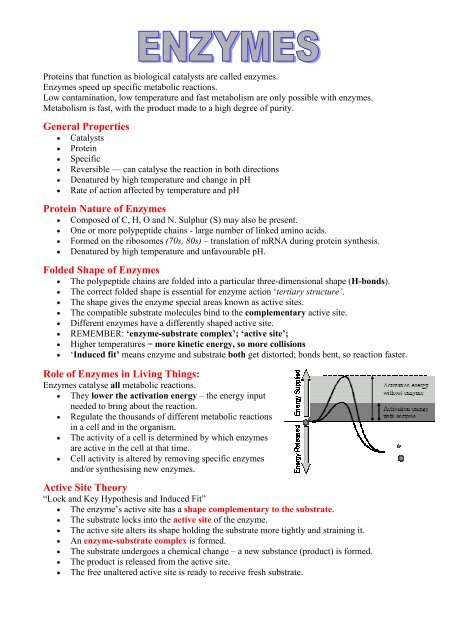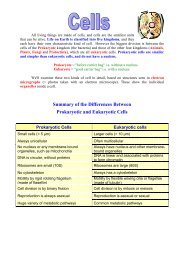Factors Affecting Enzyme Action - BiologyMad A-Level Biology
Factors Affecting Enzyme Action - BiologyMad A-Level Biology
Factors Affecting Enzyme Action - BiologyMad A-Level Biology
Create successful ePaper yourself
Turn your PDF publications into a flip-book with our unique Google optimized e-Paper software.
Proteins that function as biological catalysts are called enzymes.<br />
<strong>Enzyme</strong>s speed up specific metabolic reactions.<br />
Low contamination, low temperature and fast metabolism are only possible with enzymes.<br />
Metabolism is fast, with the product made to a high degree of purity.<br />
General Properties<br />
• Catalysts<br />
• Protein<br />
• Specific<br />
• Reversible — can catalyse the reaction in both directions<br />
• Denatured by high temperature and change in pH<br />
• Rate of action affected by temperature and pH<br />
Protein Nature of <strong>Enzyme</strong>s<br />
• Composed of C, H, O and N. Sulphur (S) may also be present.<br />
• One or more polypeptide chains - large number of linked amino acids.<br />
• Formed on the ribosomes (70s, 80s) – translation of mRNA during protein synthesis.<br />
• Denatured by high temperature and unfavourable pH.<br />
Folded Shape of <strong>Enzyme</strong>s<br />
• The polypeptide chains are folded into a particular three-dimensional shape (H-bonds).<br />
• The correct folded shape is essential for enzyme action ‘tertiary structure’.<br />
• The shape gives the enzyme special areas known as active sites.<br />
• The compatible substrate molecules bind to the complementary active site.<br />
• Different enzymes have a differently shaped active site.<br />
• REMEMBER: ‘enzyme-substrate complex’; ‘active site’;<br />
• Higher temperatures = more kinetic energy, so more collisions<br />
• ‘Induced fit’ means enzyme and substrate both get distorted; bonds bent, so reaction faster.<br />
Role of <strong>Enzyme</strong>s in Living Things:<br />
<strong>Enzyme</strong>s catalyse all metabolic reactions.<br />
• They lower the activation energy – the energy input<br />
needed to bring about the reaction.<br />
• Regulate the thousands of different metabolic reactions<br />
in a cell and in the organism.<br />
• The activity of a cell is determined by which enzymes<br />
are active in the cell at that time.<br />
• Cell activity is altered by removing specific enzymes<br />
and/or synthesising new enzymes.<br />
Active Site Theory<br />
“Lock and Key Hypothesis and Induced Fit”<br />
• The enzyme’s active site has a shape complementary to the substrate.<br />
• The substrate locks into the active site of the enzyme.<br />
• The active site alters its shape holding the substrate more tightly and straining it.<br />
• An enzyme-substrate complex is formed.<br />
• The substrate undergoes a chemical change – a new substance (product) is formed.<br />
• The product is released from the active site.<br />
• The free unaltered active site is ready to receive fresh substrate.
Denatured <strong>Enzyme</strong>: an enzyme that cannot operate because the shape of its active site is altered<br />
thus the substrate cannot combine with it – change in shape resulting in loss of biological function.<br />
Denaturation<br />
• Heat is a form of energy. The addition of heat can cause a change in the tertiary structure<br />
of a protein (mainly by breaking H-bonds).<br />
• The new shape results in a change in the chemical properties of the protein.<br />
• The protein is denatured if the shape change causes it to lose its normal biological activity.<br />
• Heat-induced denaturation is not usually reversible.<br />
• PH-induced denaturation is usually reversible<br />
<strong>Factors</strong> <strong>Affecting</strong> <strong>Enzyme</strong> <strong>Action</strong><br />
• <strong>Enzyme</strong> action occurs when the enzyme and substrate collide ‘enzyme-substrate complex’<br />
• During the collision the substrate slots into the active site of the enzyme.<br />
• Collisions happen because of the rapid random movement of molecules in liquids.<br />
(i) Temperature<br />
• at 0°C enzyme action is low because the movement of molecules is low<br />
• the collision frequency between enzyme and substrate is therefore low<br />
• increasing the temperature speeds up the movement of molecules<br />
( > kinetic energy)<br />
• more ‘enzyme-substrate complexes’ are formed<br />
• therefore enzyme action increases<br />
• maximum enzyme action at 40°C - maximum collision frequency<br />
between active enzymes and substrates<br />
• enzyme action decreases above 40°C because the enzymes are<br />
denaturing more quickly<br />
• when all the enzymes are denatured enzyme action stops (>60 o C)<br />
(ii) pH<br />
• enzyme action is greatest within a narrow range of pH, because:<br />
• all the enzymes are active<br />
• changing pH changes H-bonds, thus shape of the active site<br />
• therefore substrate can no longer bind to the active site<br />
• and so enzyme action decreases<br />
• a major pH change denatures the enzyme so enzyme action<br />
stops<br />
Optimum <strong>Enzyme</strong> Activity<br />
<strong>Enzyme</strong>s function best within a narrow range of temperature and pH.<br />
Human intracellular enzymes work best at 37°C and pH 7.
Industrial Uses of <strong>Enzyme</strong>s<br />
Bioprocessing is the use of biological materials (organisms, cells, organelles, enzymes) to carry out<br />
manufacturing or treatment procedures of commercial or scientific interest.<br />
Examples include:<br />
• Glucose isomerase: production of fructose from glucose (sweeter).<br />
• Sucrase: production of glucose and fructose from sucrose (much sweeter).<br />
• Glucose oxidase: testing of blood/urine for glucose (diabetics)<br />
• Pectinase: production of clear juice from apples/grapes etc for cider/wine-making<br />
Immobilised enzymes are not free in solution<br />
• they can be held in a bead of soft permeable gel<br />
• or coat the internal surface of a porous solid.<br />
Advantages of Immobilised <strong>Enzyme</strong>s<br />
• Easier purification of the product as the separation of the enzyme beads is not a problem.<br />
• Easy to recover and recycle the enzymes – more economical process.<br />
• The enzymes remain functional for much longer as it is a gentler process<br />
• Therefore cheaper<br />
• Best to use thermostable enzymes as these<br />
o last longer<br />
o and work at higher temperature, thus faster<br />
Bioprocessing Procedure<br />
• Bioprocessing with immobilised enzymes is carried out in a bioreactor.<br />
• The gel beads, with the immobilised enzymes, are held in suspension in the nutrient<br />
medium.<br />
• The bioreactor is sterile – micro-organisms would<br />
o contaminate the product and<br />
o reduce yield.<br />
• Temperature, pH, substrate and product concentration and waste level are checked<br />
constantly (computer).<br />
• The product can be produced by continuous flow (better) or by batch processing.
Practicals<br />
To Determine the Effect of pH on the Rate of <strong>Enzyme</strong> <strong>Action</strong>.<br />
• Substrate: starch. <strong>Enzyme</strong>: amylase.<br />
• Use the same volume of the same substrate and enzyme solutions.<br />
• Temperature at 37°C: heated water bath and thermometer.<br />
• Different pH values: use buffer solutions – pH 3, pH 5, pH 7, pH 9, pH 11.<br />
• Experiment: starch + buffer + amylase.<br />
• Control: starch + buffer + water.<br />
• Each minute test a small sample of experiment and control for starch using iodine.<br />
• Control Results: no starch break down as blue-black is the constant result.<br />
• Experiment Results: record the time at which each first produced a yellow-brown result.<br />
• Yellow-brown means starch is not present, therefore starch breakdown occurred.<br />
• Calculate rate of enzyme activity: Rate = 1/time<br />
• Repeat many times to verify the results.<br />
• Graph the results – pH on x-axis.<br />
To Determine the Effect of Temperature on the Rate of <strong>Enzyme</strong> <strong>Action</strong><br />
• Use the same volume of the same substrate and enzyme solutions.<br />
• Constant pH: – use a buffer solution.<br />
• Different Temperatures: 0°C – use ice bath, 20°C – room temperature, use a heated water<br />
bath and thermometer for temperatures greater than room temperature (30°C, 40°C,<br />
50°C….)<br />
• Control: substrate + buffer + water (? + boiled enzyme).<br />
• Each minute test a small sample of experiment and control<br />
• Control Results: no change<br />
• Experiment Results: record the time at which change visible<br />
• Calculate rate of enzyme activity: Rate = 1 /time<br />
• Repeat >3 times to verify the results.<br />
• Graph the results – temperature on x-axis.<br />
Prepare an <strong>Enzyme</strong> Immobilisation and Examine its Application<br />
Preparation of Immobilised <strong>Enzyme</strong><br />
• Prepare a solution of calcium chloride.<br />
• Mix sodium alginate and amylase solutions.<br />
• Draw the mixture into a syringe.<br />
• Gently squeeze drops of the mixture into the calcium chloride solution.<br />
• Allow the beads of immobilised amylase to harden in the calcium chloride solution.<br />
• Collect the beads in a strainer and wash with distilled water.<br />
Examination of the Application of Immobilised <strong>Enzyme</strong><br />
• Control Jar: amylase solution mixed with a starch solution.<br />
• Experiment Jar: immobilised enzyme beads in the same volume of the starch solution.<br />
• Temperature: 20°C – room temperature.<br />
• Swirl both jars equally.<br />
• Every minute test a sample from each for starch using iodine.<br />
• Record the time to achieve a yellow-brown colour – starch breakdown completed.<br />
• Now test for reducing sugar using Benedict’s Reagent – brick-red colour forms.<br />
Note that it is much easier to remove the immobilised enzyme than the free enzyme from the<br />
product solution and the immobilised enzyme beads can be easily reused.
Regulation of <strong>Enzyme</strong>s<br />
Competitive Inhibition<br />
Inhibitor is a similar-shaped molecule competes with the substrate for active sites.<br />
Non-competitive Inhibition<br />
Another form of inhibition involves an inhibitor that binds to an allosteric site of an enzyme. An<br />
allosteric site is a different location than the active site.<br />
The<br />
binding of an inhibitor to the allosteric site alters the shape of the enzyme, resulting in a<br />
distorted active site that does not function properly.<br />
The binding of a non-competitive inhibitor is usually<br />
temporary. Poisons are inhibitors that bind<br />
irreversibly. For example, penicillin inhibits an enzyme needed by bacteria to build the cell wall.<br />
Feedback<br />
Inhibition<br />
Negative<br />
feedback inhibition is like a thermostat. When it is cold, the thermostat turns on a heater<br />
which produces heat. Heat causes the thermostat to turn off the heater. Heat has a negative effect on<br />
the thermostat; it feeds back to an earlier stage in the control sequence as shown below:<br />
Many<br />
enzymatic pathways are regulated by feedback inhibition. As an enzyme's product<br />
accumulates, it turns off the enzyme just as heat causes a thermostat to turn off the production of<br />
heat. The end product of the pathway binds to an allosteric site on the first enzyme in the pathway<br />
and shuts down the entire sequence.<br />
© IHW March 2005
















